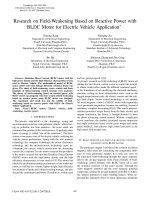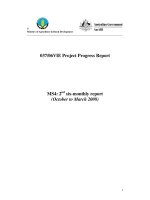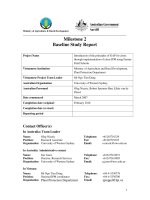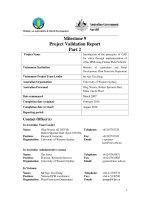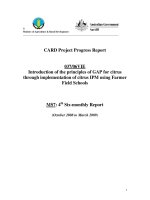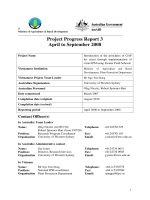Farmers Field Schools
Bạn đang xem bản rút gọn của tài liệu. Xem và tải ngay bản đầy đủ của tài liệu tại đây (773.13 KB, 49 trang )
1 | P a g e
2009
2009
MECO-ECOTRA & SPERI
SOCIAL POLICY ECOLOGY
RESEARCH INSTITUTE
SPERI
Vietnam - June 2009
MECO-ECOTRA & SPERI
SOCIAL POLICY ECOLOGY
RESEARCH INSTITUTE
SPERI
Vietnam - June 2009
SPERI YEARLY REPORT
SOCIAL POLICY ECOLOGY RESEARCH INSTITUTE (SPERI)
Address: A4, Pham Huy Thong Str., Ba Dinh District, Hanoi-Vietnam
Tel: +84-4-37717367
Fax: +84-4-37716691
Email:
Website:
MECO-ECOTRA PROGRAM - VN102011
June 2009
2 | P a g e
Table of contents
Contents
Pages
Part I: Introduction 4-18
Summary
Key achieved indicators from Jul 2008-Jun 2009
Key challenges: overall and specific need to be
addressed
Updated continuing MECO-ECOTRA
Part II: Yearly report of MECO-ECOTRA
thematic networks and SPERI’s departments
19-158
Network on Customary Law in Watershed
Resources Management
Laos-Thailand-Vietnam Traditional Culture Herbal
Medicine
Laos-Thailand-Vietnam Traditional Handicraft
MECO-ECOTRA in Quang Binh province -
Vietnam
MECO-ECOTRA in Laos
Farmers Field Schools (FFSs)
Department of Foreign Cooperation (DEFO)
Department of Administration (DAD)
Part III: Annex 148-199
Report of permaculture volunteer - Mrs. Rebecca
Hunter
Report of permaculture volunteer - Mr. Robert
Gray
Report of English Teaching volunteer - Mrs.
Mirriam Mackintosh
Report of AYAD volunteer - Mr. Mark David
Agnew
MoU between SPERI and VTC
3 | P a g e
Farmers Field Schools (FFSs)
4 | P a g e
FFSs have its original name i.e. vocational training schools.
Since the end of August 2007, SPERI adopted FFSs as the new
uniformed name applied for the three school sites: FFS-Simacai
in Lao Cai district, FFS-HEPA in Ha Tinh province, and FFS-
Dong Le in Quang Binh province.
The reason for this change was derived from a strong priority
SPERI wished to reach closer to the farmers’ movement
towards promoting eco-farming practices, better conducting
farmers-training by field-based, hands-on, and have attached-
farm sites as demonstration. The drive also came from when
SPERI foresaw the need to build capacity for young indigenous
followed the current MECO-ECOTRA farmers’ networks.
Presently, FFSs have trained 81 indigenous students coming
from 10 different indigenous groups in Laos and Vietnam.
During the 2006-09, FFSs give training on basic skills in eco-
farm, maintain the integrity of aspects of local culture,
traditional studies, English and computing skills, and other
farming techniques. FFSs encourage the application of local
knowledge, revival of local seeds/species, and promoting local
innovative practices/solutions.
In the future, FFSs will be expanding at three levels - household,
community, and regional. Learning environment for indigenous
youths would be best, particularly at the hands-on training and
applied aspects, at their families and communities. To reach out
at the Mekong regional level, the potential of developing a FFS
site at community level in Luang Prabang province, Laos may
be possible with Bread for the World.
In 2009-12, FFSs at all levels will be assisting MECO-
ECOTRA’s transformed networks in conducting studies,
training, and application on three cross-cutting themes: (1)
community institution in watershed resources management, (2)
eco-farming, and (3) community-based eco-enterprise.
TABLE OF CONTENTS
Table of contents......................................................................................................................3
Contents....................................................................................................................................3
Part I: Introduction of FFSs......................................................................................................8
Formation of FFSs............................................................................................................8
Strategy of FFSs...............................................................................................................8
Who are FFSs?...............................................................................................................10
Part II: Evaluating Training System in FFSs.........................................................................11
Scoring FFSs......................................................................................................................11
Training Program ..............................................................................................................13
FFS-Simacai...................................................................................................................13
FFS-HEPA.....................................................................................................................13
FFS-Dong Le..................................................................................................................14
Training Contents...............................................................................................................14
FFS-Simacai...................................................................................................................15
FFS-HEPA.....................................................................................................................15
FFS-Dong Le..................................................................................................................15
Training Modules...............................................................................................................16
Courses at FFS-Simacai.................................................................................................16
Courses at FFS-HEPA...................................................................................................17
Courses at FFS-Dong Le................................................................................................20
Curriculum at FFSs........................................................................................................22
Training Method ................................................................................................................30
FFS-Simacai...................................................................................................................30
FFS-HEPA.....................................................................................................................30
FFS-Dong Le..................................................................................................................31
Process of Selecting Students............................................................................................32
Target groups..................................................................................................................32
Criteria............................................................................................................................32
Selection procedures .....................................................................................................33
Course Organization...........................................................................................................33
Timing ...........................................................................................................................34
Location..........................................................................................................................34
Coordination between FFSs and farm sites ..................................................................34
5 | P a g e
Class Management ............................................................................................................34
Evaluation of Students Outcomes......................................................................................35
Marking system..............................................................................................................35
Performance of practical skills, onsite attitude in learning...........................................35
By teachers’ comments..................................................................................................35
Students evaluate Training System................................................................................35
Quality of Teachers ...........................................................................................................36
Evaluate other Factors........................................................................................................38
Continuity in training.....................................................................................................38
Strengthening linkages...................................................................................................38
Enhancing inheritance....................................................................................................38
Intergeneration in training..............................................................................................38
Effectiveness indicators (after training at FFSs)...............................................................38
Part III: Drawbacks and challenges ......................................................................................39
Drawbacks..........................................................................................................................39
Training program...........................................................................................................39
Executive frameworks....................................................................................................39
Training method.............................................................................................................39
Target groups .................................................................................................................39
Management and training operation..............................................................................39
Staff ...............................................................................................................................40
Students’ Innovation Fund ............................................................................................40
Challenges .........................................................................................................................40
Part IV: Sharing from students...............................................................................................41
Sharing from Lộc Văn Vìn, Sán Dìu minority student ................................................42
Sharing from Giàng A Sử, H’Mông minority student...................................................42
FFS-Simacai...................................................................................................................43
FFS-HEPA.....................................................................................................................43
Part VI: Cooperation in Training ..........................................................................................44
Macro level.........................................................................................................................44
Inside Vietnam: .............................................................................................................44
Outside Vietnam:...........................................................................................................44
Micro level.........................................................................................................................46
Within Vietnam:.............................................................................................................46
Outside Vietnam:...........................................................................................................47
6 | P a g e
Remarks made by collaborators ........................................................................................48
FFSs................................................................................................................................48
FFS-Simacai ..................................................................................................................48
FFS-Dong Le..................................................................................................................49
7 | P a g e
Part I: Introduction of FFSs
Formation of FFSs
Through the stages of development, SPERI and sister organizations have maintained long
relationships with grassroots communities including elders, women, farmers, and the young
minorities. The period 2005-2015 is the timeframe that SPERI concentrates on the youths.
SPERI set tied relationship with minority youths through strategic training environment i.e.
Farmers Field Schools.
Periods The development of the relationship between target
groups andSPERI and sister organizations
Target groups
2005-2015 MECOECOTRA & YIELDS
- SPERI -
Young minority groups
are trained in FFSs
1997-2004 MECOECOTRA
- SPERI -
Farmer groups
and community
1989-1999 TEW-CHESH-CIRD Community members including
village elders, the spiritual
leaders of the community, and
different farmers’ interest
groups.
Strategy of FFSs
SPERI give FFSs strategy with long-term vision - desired FFSs will be a space, the
democratic environment to transmit SPERI’s priority issues to the youth groups
(YIELDS
1
). The priority issues include: rights of minority people, working approach
towards empowering minority communities, ways to maintain minority knowledge and
experiences.
FFSs maintain linkages with MECO-ECOTRA’s community development activities in
order to continue enhancing values such as cultural identity, customary practices, and
voices of the youths. Minority youths are the future of the community and the future of
world; therefore, FFSs see its stronger role in keeping closer contact with youth groups to
ensure the maintenance of these values exist by the continuity of intergenerational lengths.
FFSs strategy is implemented, including what has been done:
SPERI sets up a system of FFSs training environment which allocate at 3 different
provinces, with long term land use right. At each province, FFS has good
relationships with local authorities.
FFSs training schools are operated by the local human resources. Our training
classes target small sizes of students yet aim at high quality in the outcome and
expecting students return to communities to make the most of applications.
FFSs sites have different space-scale practiced environment, with the advantage in
the landscape that near areas of early yet sensitive ecosystem resources.
1
Young Indigenous Ethnic Leadership Development Strategies.
8 | P a g e
FFSs infrastructure systems are relatively fine developed. Currently, FFSs are
refining our attached-farm models (inside the FFSs) to be used onsite examples.
FFSs’ training sector has operated officially 1 year old; and will in the future
improve the training processes towards professionalize better quality at delivering
our training programs including organization, operation, and management of
outcomes.
All the current FFSs sites have their platform development since the foundation of the old
model CCCDs.
FFS-Simacai FFS-HEPA FFS-Dong Le
CCCD/NIRD HEPA CCCD/CIRD
NIRD/TEW HEPA/CHESH CIRD/CIRD
During the period 2006-08, many of the MECO-ECOTRA community development
activities incorporated the training function and our search for youth resources. See table 1
on the collaborative activities between FFSs and other MECO-ECOTRA thematic
networks.
In the 2008-09, FFSs focus on training functions including training programs and activities.
In the future, FFSs will tight training activities together with development of our farm sites
including varied farm satellites. FFSs aim at do well at the three interrelated functions:
hands-on training, onsite trial and application, and also production aspect of all farms.
9 | P a g e
Who are FFSs?
FFSs is an English acronym for Farmers Field Schools. Vietnamese name is Trường Đào
tạo Thực hành Nông dân Chuyên nghiệp. SPERI has a system of 3 FFSs, allocated at three
provinces in the northern, northern central and central Vietnam.
Some of the current pictures illustrate students are training at different FFS sites.
FFS-Simacai FFS-HEPA FFS-Dong Le
Students of the K6B class
practicing making compost
(Feb, 2009)
Students of the K1A class
practicing group work in
terracing (April, 2009)
Ma Lieng students observing
veggie garden
(March, 2009)
10 | P a g e
FFS-Simacai
- official year of training 2006
- area for training: ~ 4 ha/9.27 ha
- Simacai district, Lao Cai province
FFS-HEPA
- official year of training end of 2007
- area for training ~ 15-20 ha/400 ha
- Huong Son district, Ha Tinh province
FFS-Dong Le
- official year of training end of 2007
- area for training 14.7 ha
- Tuyen Hoa district, Quang Binh province
Part II: Evaluating Training System in FFSs
Scoring FFSs
The FFSs have serious look and evaluate scoring. Retrieved SPERI philosophy as standard
and used strategic focus on ecological agriculture training as a measure in a range of 0-
100% (0%: lowest performance, 100%: highest performance); below is our internal
evaluation marks (period 2006 – June, 2009):
Internal assessment of the FFSs education system
FFS-Simacai FFS-HEPA
FFS-Đồng Lê
INDICATORS
Term 1 Term 2
Training program
Rationale? 50% 70-80% 60%
Practical operation? 50% 65-70% 90% 60%
Holistic training contents
Relevance to context? 60-65% 65-70% 80% > 80%
Interdisciplinary approach? 40% 50-60% 90% 95%
Indepth level? 60% 60% 90% 70%
Training modules?
Quality of content? 50% 70-75% 80% 80%
Quality of curriculum? 50% < 50% 90% 90%
Training methodology
Students based approach 75%
Implementation of students based
approach; 30-40% 75% 80% 80%
Divide between theory and practical 70% 70% > 80% 80%
Students intake
Target groups? 100% 75% 100% 100%
Criteria? 60% 60% 50%
Based on
context
Selection approach? 70% 70% 30-35% No selection
Course organization
Timing? 80% Average Relevant Relevant
Location? 80% A bit fixed Crises Relevant
Coordination between FFSs and farm
sites 20% 20-30% Not yet Not yet
Students management
Self management 80% 60% Yes Yes
Class rules 80% Yes 50% 70%
In line with FFS regulations 90% 60-70% 70% 70%
With respect to SPERI rules 90% 60-70% 70% 70%
Evaluation of students outcomes?
11 | P a g e
Through marking system? 15-20% Not yet
By onsite real works
(performance of practical skills,
attitude in learning) 50-60% 90% 80%
Through teachers’ comments? 50% Not yet 100%
Quality of teachers? (farmers group, development workers, and outsource teachers)
Farmers
Specialization, experiences? Good Very good 90%
Training method? 50% 80% 90%
Development
workers
Specialization, experiences? Tốt 75% 60% 80%
Training method? 50% 70%
Outsource
Specialization? 90% Not much 70%
Experiences? 40% 70%
Training method? 50% 70%
Other factors
Continuity 90%
No so well,
35% 40%
- rotation between modules
- seasonal training
- from one course to the next
Linkages with thematic networks 60%
35% with
handicraft, and
customary lw
networks
20%
Inheritance from community
development lessons learnt
K5A did better
than K6B
Below medium,
but potential is
large
0%
Intergeneration (elderly, mid-age, and
youths) 40% 45% 10% 20%
Evaluation of effectiveness (after graduation)?
only be
evaluated after
5 years time
only be
evaluated after
5 years time
only be
evaluated after
5 years time
only be
evaluated after
5 years time
12 | P a g e
Training Program
Training program is assessed at 2 sub-indicators: rationale of the training framework, and
its actual operation.
Basis of the rationale strongly reflects the volume and quality in rich in 15 years’
experiences that SPERI has long worked with ethnic minorities. The training
framework shows interests and desires in designing subjects as well as training
method which are most relevant and closely feasible to students’ concerns and
needs. The training program, at both rationale and practical levels, well integrate
the community aspect in development and the development value based strongly on
the community.
Designing the training program aims at addressing the current issues and give
training towards finding solutions to the problems that are of worldwide attention.
For example, the program search for local solutions to the global issues, local
innovations on green and clean agricultural practices, and the ability to mobilize
optimal local resources to solve local problems.
All FFSs have the training program in which have ensured factors that uniformly respect
SPERI’s philosophy yet still reflect each school’s specialize features, specific
circumstance, and actual operation.
If taken by SPERI philosophy as standard and content-oriented priorities in training in
FFSs of ecological agriculture as a measurement point with 0-100% (0%, worst, and is
100% absolute), then, the difference now between 3 schools is:
Training program FFS-Simacai FFS-HEPA FFS-Dong Le
Rationale? 50% 70-80% 60%
Actual operation? 50% 65-70% 60%
FFS-Simacai
The program is influenced by the framework set up by Lao Cai State-based Vocational
College. Therefore, the rationale is only limited at 50% both at design and operation stages.
The ability for SPERI to make influences is too minor. The running of the program is
heavily dominated by resources from Lao Cai vocational college including curriculum,
training content, training method, evaluation system, and also human resources.
FFS-HEPA
Designing training program for FFS-HEPA has a different foundation and involves mainly
SPERI members. The program is designed to be a SPERI pioneering initiative that plays as
a strategic step in transforming the 15 years of community development experiences to
now become lessons for the community youths. Basis of the program reflected an approach
in incorporating the 'macro vision' with local contexts, knowledge and practices to address
many aspects of emerging issues concerning human environment, human behavior with
nature, and the future sustainability of the Earth and humanity.
13 | P a g e
Attempts in designing the training framework have reached 70-80% as the program does
feature aspects of inheriting good, unique, and successful stories/lessons and advantages
from SPERI’s 15 years’ working experiences. As 2008 is the 1
st
year to run this trial
program so chances of successes are only at 65-70%. Many colleagues at FFS-HEPA still
find the training program as the new front to be challenged with.
FFS-Dong Le
FFS-Dong Le is known as a centre for strengthening community capacity (CIRD);
however, operate as functional depth of a training center to meet many demands is still
limited in capacity. In 2008, FFS-Đồng Lê ran a training program specific for Ma Lieng
minority youths and the program was divided into two terms. For self-assessment purpose,
only 60% success rate at the program design and the actual deployment is about at similar
rate.
Training Contents
This indicator is assessed by the three sub-indicators: relevance of the topics taught with
relation to the context of community, the interdisciplinary approach among varied courses’
contents, and the level of depth of each unit course.
The relevance of topics taught is reflected through the content at teaching, timing to
teach, and teacher resources whose knowledge and experiences expected to be
profound. Teaching content put high focuses on practical aspects of ecological
agriculture training (which existed from long tradition). Hands on practical units are
conducted with good seasonal timing and in a closed to nature environment that
allow students easily absorb knowledge. Open air teaching landscape also allows
students create the more dynamic part of their learning process. Teacher resources
are mainly experienced farmers and spiritual village elders whom are familiar with
students, making students feel less strange in language they perceive and contents
they wish to learn.
Interdisciplinary approach among courses’ contents is assessed at the very low
level. To train at quality-focus of ecological agriculture training, the training
contents must incorporate an interdisciplinary approaching i.e. linkages between
livestock raising, fruit and vegetable gardening, and other necessary farm
components. The nature of ecological agriculture is a system that includes
components be linked together logically and interconnected. Therefore, training
content in the future needs to improve this section.
The level of depth of each unit course is addressed at low level. This mainly dues to
the teaching staff do not have a strong background in agricultural farming. Their
attendance at teaching is also low particularly with courses that are seasonal
farming.
14 | P a g e
The difference between 3 schools is:
Holistic Training Contents FFS-Simacai FFS-HEPA FFS-Dong Le
Relevance to context 60-65% 65-70% 80%
Interdisciplinary 40% 50-60% 95%
Specialization 60% 60% 70%
FFS-Simacai
As of the influences of Lao Cai vocational state-based training program, most of the
courses show a lack of relevancy to contexts specific to students’ studying needs, or
address community concerns. Quality of the training content is so only at 60%.
Interdisciplinary approach among courses’ contents is very low 40%. The in-depth level
reaches only 60% out of 100% desire.
FFS-HEPA
The training contents at HEPA attempt to incorporate the most practical aspects and
familiar conditions in content delivery (i.e. close to the community, and students’ contexts).
70% does not yet reflect the full ‘quantity’ and ‘quality’ of the school’s effort; yet,
expecting FFS-HEPA to continue improving the training contents that meet higher
demands from the larger community. Interdisciplinary approach among courses is at low
50%. The depth level per course needs to be upgraded, only at 60%.
FFS-Dong Le
Total number of students in FFS-Dong Le is usually modest, small size classes does not
mean low quality. The training coordinator in FFS-Dong Le has had experiences working
with HEPA and Simacai; hence, when designing the training contents, many adjustment
have been made to well suit with the students. The contents rich and appropriateness reach
80%. Dong Le is itself a production site with many functional sub-systems including
irrigation, animal raising zones, fish ponds, gardening areas, nursery, crops system, and
also waste processing. Interrelatedness between sub-systems is high, 95%. Setting of the
site has an advantage that allows an easy conduction of many practical aspects of the
training. The specialization per system component is however still low. FFS-HEPA and
FFS-Simacai should increase their trips to FFS-Dong Le to learn from the site.
15 | P a g e
Training Modules
Rating specific training modules focuses on 2 sub-indicators: quality of content and quality
of curriculum. Under self-assessment, the difference between FFSs efforts is:
Training modules FFS-Simacai FFS-HEPA FFS-Dong Le
Quality of content 50% 70-75% 80%
Quality of curriculum 50% < 50% 90%
Courses at FFS-Simacai
Courses taught for K5A class were much closer to the training program set up SPERI.
Significant unit hours were allocated to eco-agriculture course; networking and community
development course. Sessions of local knowledge and cultural values were incorporating
substantially. English and computing skills were distributed with larger amount of time.
Courses teaching for K6B class are influenced by Lao Cai vocational college in terms of
unit hours and teaching staff. Number of hours for English and computing skills are too
16 | P a g e
limited. Most of the courses reflect heavy theoretical contents, less emphasis on practical
skills. Technical components on agricultural cultivation, animal husbandry have been
conducting with little attention on strengthening local species, local resources and
experiences. Efforts from SPERI in integrating its training program are rather susceptible.
In total, the contribution from SPERI teaching resources is only 32.05% through two unit
courses (1) plant protection, and plant diseases and (2) all the practical hours.
Curriculum quality for courses provided by the Lao Cai vocational colleges is still heavily
theoretical; therefore will bear higher risk if still existing the intact copy of knowledge
from one place to another. Curriculum-building lacks a process of going through practical
observation with proper findings and experiment (therefore, a degree of specific and
authentication is small).
Courses at FFS-HEPA
Lớp Quế Phong + lớp Mã Liềng + lớp K6B
Môn học Nội dung học tập Thời gian
Giao lưu, nghe chia sẻ của lớp Mã Liềng
Nghề truyền thống Tìm hiểu nghề mộc
Nghe lớp Mã Liềng báo cáo tổng kết ngày học
Nghe chia sẻ của cô Lành
Nghe lớp Quế Phong báo cáo tổng kết ngày học
Chia sẻ về kiến thức về cây của các bạn
Tiếp tục thảo luận các câu hỏi ngày hôm qua
Nghe cô Lành chia sẻ
Hợp phần nông nghiệp sinh thái Tham quan vườn ươm
Đi tham quan HEPA
Tổng kết ngày học 15/12
Nghề truyền thống Nghỉ. Lấy sắn về làm rượu cần
Nghề truyền thống Làm rượu cần 17/12/2007
Tham gia chuẩn bị cơm đón đoàn Lạng Sơn
Báo cáo kết quả ngày học 15/12
Tham quan mô hình Tham quan mô hình anh Kiên
Tham quan mô hình Tham quan mô hình cô Dung
Làm quen với các bạn Lạng Sơn, thống nhất ghi chép sổ ghi đầu bài, bầu
lớp trưởng, lớp phó
Tổng kết ngày học 18/12/2007
Tham gia tổng kết cùng đoàn Lạng Sơn
Giao lưu văn nghệ cùng toàn thể mọi người và đoàn Lạng Sơn
Tiếp tục tổng kết ngày học 18/12/2007
Tham quan mô hình Tham quan học tại mô hình anh Kiên
Nghề truyền thống Học làm móc áo treo tường 22/12/2007
Máy tính Tập gõ máy tính
Nghề truyền thống Học làm hộp đựng bằng gỗ
Tổng kết lớp học 23/12/2007
Lớp K1A
Môn học Nội dung học tập Thời gian
Tham quan, học tập, trao đổi chia sẻ về
Permaculture
Cô Marisha và Ruth (Permaculture-USA) Tháng 1/08
Bản sắc văn hoá (Luật tục truyền
thống_phần 1)
Luật tục trong thờ thần cây Đa Tuần 4 tháng 1/08
17 | P a g e
Hình thành các cách hiểu và các khái
niệm
Cách hiểu và khái niệm về: Lấy học sinh là trung tâm, NNBV, sinh thái
thực vật, kiến thức cộng đồng…..
Toàn tháng 2/08
Bản sắc văn hoá (Luật tục truyền
thống_phần 1)
Luật tục trong quản lý tài nguyên và trong canh tác nông nghiệp Tuần 3 tháng 3/08
Luật Nhà nước trong quản lý đất đai
(phần 1)
Một số điểm trong các văn bản luật của NN liên quan đến quản lý và sử
dụng đất đai
Tuần 2, 3 tháng 3/08
Nghề truyền thống Chuyen de Làm guồng nước Tháng 3/08
Luật tục Chuyên đề lụât tục: già Xuyên và anh Dũng – đi đền 9 gian Tháng 4/08
Quản lý nguồn nước
QHTK nguồn nước hợp lý.
Các biện pháp thiết kết và sử dụng hợp lý nguồn nước
Tuần 2, 3 tháng 2/08
Tuần 1, 2 tháng 4/08
Qui hoạch và thiết kế trang trại (Hợp
phần về qui hoạch và nhận diện cảnh
quan)
Các nguyên tắc cơ bản trong QHTK, ứng dụng từ hệ sinh thái tự nhiên
trong QH…
Tuần 2, 3 tháng 2/08
Tuần 1, 2 tháng 4/08
Luận chứng trang trại (phần 1)
Tổng quan về luận chứng trang trại, nhu cầu cần phải xây dựng trang trại
theo hướng bền vững
Tuần 3, 4 tháng 4/08
Máy tính
Chuyên đề vi tính: word, excel, ppt, sử dụng email nội bổ, sử dụng
internet, format, tính toán excel
Tháng 5/08
Tiếng Anh
Học tiếng anh qua: Bài hát, các vật dụng trong nhà, các vật ngoài vườn,
các hiện tượng thời tiết.
Học thông qua thực hành
Tuần 1, 2 tháng 6/08
Môi trường
Kiểm toán sử dụng nước
Sự nóng lên của khí hậu toàn cầu
Hệ mặt trời
Phim về ô nhiễm môi trường
Tuần 1, 2 tháng 6/08
Đất
Các vấn đề đất đại tại các cộng đồng
Dinh dưỡng đất, xói mòn đất…
Tuần 3, 4 tháng 6/08
Hệ sinh thái rừng
Tính đa dạng, các chu trình vật chất và năng lượng, chu trình phân huỷ
các chất hữu cơ…
Rừng và các vấn đề tranh chấp rừng và đất rừng ở các công đồng.
Tuần 3, 4 tháng 6/08
Luật tục (tín ngưỡng trong bảo vệ
TNTN)
Tham gia xây dựng miếu thờ H7 Tháng 6-7/08
Nghề truyền thống Trồng Dâu - giống lấy từ Lào về Tháng 7/08
Chuyên đền thảo luận bắt buộc: Nhật ký
nông hộ
Thảo luận về tầm quan trò, vai trò và ý nghĩa của việc ghi chép nhật ký
nông hộ
Thảo luận về các nguyên tắc và đạo đức trong ghi chép
Tìm hiểu thực trạng ghi chép của 2 nông hộ
Thực hành thiết kết bộ khung ghi chép nhật ký thực tập sản xuất
Tuần 5 tháng 7/08
Chuyên đề hạch toán kinh tế nông hộ
Hạch toán kinh tế và luận chứng trang trại
Tháng 7/08
Tham quan
Thăm quan của đoàn Outervoice: 8/2008 phỏng vấn 03 mô hình hoc sinh
Tháng 8/08
Chuyên đề thực tập
Thực tập sản xuất chuyên đề: 3 nhom (1) chăn nuôi lợn – gà và làm vườn
(2) chăn nuôi gà, ngan, trồng các loại rau màu (3) thực tập chăm sóc cây
ăn quả, trồng cây rau màu, nuôi gà, cá tại vườn trước văn phòng.
Từ 7-9/2008
Chuyên đề thực hành tấp tủ
Chuyên đề thực hành tấp tủ của thầy Châu: mỗi tuần 02 buổi vào chiều
thứ 3 và chiều thứ 6. Địa điểm tại vườn cây ăn quả.
Tháng 7-9/08
Chuyên đề thực tập
Thực hành các kỹ năng đã học về QHTK hệ thống.
Ứng dụng các bài học (nguyên lý) vào thực tiễn
Thực hành xây dựng luận chứng trang trại qui mô nhỏ
Từ tháng 7-12/08
Chuyên đề TOT thực tập
Học TOT-ADDA: vào các thứ 5 hàng tuần : sinh lý cây cà chua từ lúc
gieo ươm đến lúc thu hái: Thanh Trung
Từ tháng 8/2008 - đến 1/2009
18 | P a g e
Chuyên đề làm chế phẩm EM
Chuyên đề làm chế phẩm EM, với đào tạo tạo tán, tỉa cảnh, dau đó mang
EM ra phun cho cây
Tháng 8/08
Thực tập Tạo tán, tỉa cành
Chuyên đề tạo tán, tỉa cành
Tháng 8-9/08
Hợp phần nông nghiệp sinh thái
Chuyên đề Lát cắt sinh thái
1-10/10/08
Chuyên đề nâng cao nông nghiệp sinh
thái
Chuyên đề nuôi giun lấy liquid của chị Lisa Toàn tháng 10/08
Chuyên đề phân loại rác của chị Lisa
Xử lý rác thải, phân loại các loại rác không phân huỷ vào các thùng rác:
Rebecca
Chuyên đề chăn nuôi Chicken Tractor Lachlan
Chuyên đề mindmap của Robert
Các nguyên tắc: 12 nguyên tắc và 07 bước trong thiết kế quy hoạch nông
nghiệp sinh thái của Robert
Bài giảng của thầy Geoff về nông nghiệp sinh thái: food forest.
Chuyên đề tiếng Anh
Chuyên đề Tiếng Anh 10.2008: Naomi + Lachlan: dạy TA cho cán bộ;
2 tuần Tháng 10/08
Tham quan
Chuyên đề thăm quan ở Quảng Bình: 10/2008
Tháng 10/08
Chuyên đề tiếng Anh
Chuyên đề Tiếng Anh: Miriam
10.2008-> 6.2009
Chuyên đề thực tập sản xuất
Thực tập sản xuất
Từ tháng 11/08 đến nay
Đất
Các bài chia sẻ về sói mòn đất của Mark:
Tháng 11-12/2008
Chuyên đề thực tập
Thực hành xây dựng hệ thống xử lý nước thải: black and grey water của
Robert
Tháng 11-12/2008
Trồng cau, đa, xi, hoa, rau thuốc, thuốc nam tại các khuôn viên H7, đội 9
Đảo bầu Keo
Ươm cây họ đậu
Cty phân Sao Xanh tập huấn, chia sẻ về cách sử dụng phân Sao Xanh:
phân bón hữu cơ
Trồng cây găng dọc 02 bên đường từ vườn ươm vào đến trạm điện
Trồng các loại cây khác: dừa - dọc bờ sông, cọ dầu, mít, keo
Trồng cây cải tạo đất, lạc dại tại MO HINH Khe Soong
Hỗ trợ các mô hình Khe Soong và Cây Khế trồng cây màu: lạc, di chuyển
chuồng Trâu, làm nền chuồng lơn
Chuyên đề Cộng đồng
Chuyên đề chụp ảnh: tập chung vào thực hành
Thể dục buổi sáng: 7-9/2008
Tuần tra khu vực Hepa vào các buổi tối: từ tháng 7-10/2008
Sửa hàng rào
Làm đường nội bộ ra các nhà sàn trước tháng 10/2008
Làm việc cộng đồng; trao đổi các tối thứ 4
Các cuộc họp lớp hàng tuần, báo cáo tháng, đánh giá tháng.
Định kỳ đánh giá mảng đào tạo, hậu cần, cán bộ hàng tháng.
Tự chủ, xây dựng quỹ lớp, tự quản lý nguồn vốn tín dụng
Các lễ hội: Tổ chức Noel, tết dương lịch, tết âm lịch, các đợt chia tay
TNV, cán bộ,
Chuyên đề môi trường
Chia sẻ của Craig 12/2008: nóng lên toàn cầu, nhu cầu sử dụng năng
lượng, toàn cầu hoá
Tháng 12/08
19 | P a g e

